|
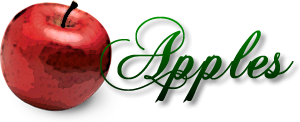
Of all fruits, apples are probably the easiest and most rewarding to grow. The selections listed herein contain varieties adapted for commercial use in Western Montana as well as very hardy, short season cultivars suited for the Northern and Chinook weather conditions of Eastern Montana. The selected varieties are bud grafted to Malus Baccata, Columbia or Dolgo Crab rootstocks. This produces a custom tree with the aggressive, fibrous, drought tolerant and winter hardy characteristics of the rootstock. We also graft a small number of trees to Emla 26, a clonal dwarfing rootstock. These dwarf trees are ideally suited for small kitchen orchards where space is limited, but are not hardy East of the Rockies. Winter weather conditions of 1990 generated temperatures and chill factors of -40 to -80 degrees F here in the Bitterroot Valley. This served as a great test for winter hardiness. Many of our standard cultivars like McIntosh and Wealthy were severely damaged; more tender varieties were killed outright. Those developed from hardier parentage in Manitoba, Saskatchewan and Prairie Regions came through unscathed and produced quality fruit the following season. |
- Battleford
- Breaky
- Carroll
- Collett
- Dakota Gold
- Duchess
- Empire
- Goodland
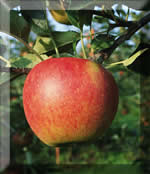 |
This variety is from a Russian apple seedling discovered in North Battleford, Saskatchewan in 1934. The fruit is 3" in diameter, striped and mottled red over a pale yellow, ripening here in late August. Battleford is rated as an excellent cooking apple and fair for eating out of hand. Battleford is very winter hardy and recommended for northern regions. Very similar to our antique Duchess and an excellent substitute where extreme winter conditions are an issue. |
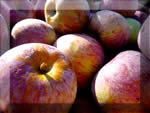 |
This cultivar was developed from a Blushed Calville seedling at the Experimental Farm, Morden, Manitoba in 1935. The fruit is ripe in early September, 2.5" to 3.5" in diameter, striped bright red over yellowish green, and stores quite well. Breaky is an excellent eating apple and good for cooking. The tree is very vigorous, hardy and productive. The extra large blossoms are impressive and give Breaky added ornamental value. An excellent selection for our more difficult sites. |
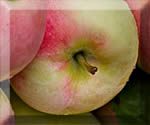 |
This is a Moscow pear X Melba cross developed at the Experimental Farm, Morden, Manitoba in 1961. This is one of our best early apples, ripening here in late August. The fruit is 3" to 4" in diameter, mottled and streaked bright red over a creamy green. It is rated excellent for eating and good for sauce. The canopy is vigorous and rounded, lateral branches originating from wide angles capable of supporting heavy crops of this wonderful fruit. Carroll is resistant to fireblight and always one of the first cultivars to defoliate in the fall, very winter hardy to -50 F. This is one of my favorite early apples, gotta have this one in your kitchen orchard. |
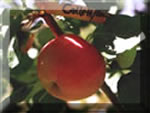 |
This apple of unknown parentage was discovered by V. Collett, Norre Dame de Lourdes and introduced by the Experimental Farm, Morden, Manitoba in 1961. The fruit ripens in late August, 3" to 3.5" in diameter and is a medium red over a creamy green. Collett is very similar to our famous McIntosh here in the Bitterroot, rated good for eating and excellent for cooking. The fruit stored well into December, the tree rated as very winter hardy. We recommend Collett for sites with a season too short for McIntosh and where fireblight and winter injury is a consideration. |
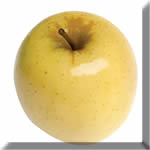 |
Selected at the USDA Fruit Breeding Station at Mandan, North Dakota in 1958, it's parentage is not known but appears similar to Yellow Transparent and or Golden Delicious. It is a very early apple, large, ripening in mid-August, rated good for eating out of hand, and for sauce and pie. While a valuable and reliable bearer, as with all early season fruit, it does not keep well. The tree is very hardy, tolerant to fireblight and recommended for Montana's harsher sites.
|
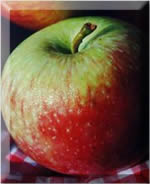 |
This antique Russian variety was imported to America from England in 1835. Well represented in selections planted in Western Montana circa 1908, many are still producing quality fruit and serve as our source for scionwood. Duchess ripens in late August with large, splashed and striped crimson over pale yellow fruit. This heirloom variety is one of the very best sauce, cider, and cooking apples available. While valued for it's resistance to apple scab, rust and fireblight, many of our Ole' Timers would consider making an apple pie from no other tree.
|
 |
This apple is a cross with McIntosh X Red Delicious, developed at the Geneva, New York, introduced in the late 60's. The fruit is medium size, lobed, with a beautiful dark red skin over a creamy white, crisp, crunchy, juicy flesh. Empire is considered a late season variety here, ripening two weeks after McIntosh. Rated as an excellent dessert apple and good for cider and sauce, Empire also holds until February in storage if well hidden. This is one of my favorite apples and is highly recommended for Western Montana and sites with a comparable growing season.
|
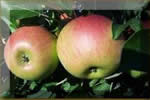 |
This cultivar was developed from a Patten Greening seedling at the Experimental Farm, Morden, Manitoba in 1931. Considered a mid-season apple, ripening in early September with large 3.5" to 4" fruit. A beautiful washed orange-red over a creamy green skin covers a crisp, juicy, tender and aromatic flesh. Goodland is excellent for eating and cooking, good for storing and quite winter hardy. This is one of the best Canadian apples and we highly recommend Goodland in the Bitterroot and northern kitchen orchards.
|
|
- Good Mac
- Haralson
- Harcourt
- Hazen
- Honeycrisp
- Liberty
- Lodi
- Luke
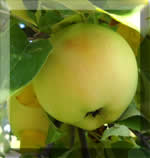 |
One of the more recent releases from Morden, Manitoba, Canada. This cultivar is a cross of two of my favorite apples, Goodland X McIntosh. A late-season fruit here in Western Montana, the large, straw colored apple ripens in early October. A gift from Clayton Berg of Helena, Montana in the 80's, Good' Mac is considered a treasure on my nursery. Distinctly different from either parent, Good' mac produces a reliable crop of crisp, crunchy dessert quality fruit. Keeps better than most in cold storage when properly hidden from the kids, also makes a great apple pie and cider blend. Highly recommended for the Bitterroot, performing well in the Helena Valley. Yummmm.
|
 |
Developed from a Melinda seedling at the Fruit Breeding Station, University of Minnesota in 1922. The fruit ripens in mid-October, 3" to 4" in diameter, greenish-yellow overlaid with an attractive red. The flesh is crisp, juicy, firm, maybe even a little tough with a pleasantly tart flavor. Haralson is winter hardy and recognized as a keeper in storage, also valued for cider and cooking. While Charles Haralson was quoted "It keeps all winter in a house with 5 boys", it has a following and is well established in Western Montana orchards.
|
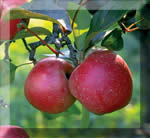 |
Of unknown parentage, this cultivar was developed at the University of Alberta in 1922. From the collection of Clayton Berg, Helena, MT. This bright red medium size apple ripens in late August here, with a pleasant sub-acid, mild flavor. Harcourt is very winter hardy and is recommended in colder, short season sites.
|
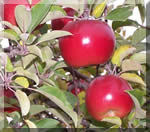 |
A cross between Duchess X Starking Delicious, the tree is a winter hardy, disease resistant, compact canopy. The fruit is large with bright red skin, over firm, juicy and slightly coarse grained flesh. A relatively new release from North Dakota University, Hazen is a pleasant dessert quality apple, also used for cooking. Valuable in harsh, short season locations.
|
 |
Released from the University of Minnesota in 1991 as a cross of Macoun X Honeygold. Apples are 3" to 3.5" in diameter, ripening in mid-September with a mottled red over yellow background. The skin is finished with small lenticels or dots covering a cream colored and coarse flesh. The exceptionally crisp, juicy and aromatic fruit also stores for months when refrigerated. While a new introduction, Honeycrisp is very popular in Western Montana. It was love at first bite for this grower. Very impressed with the high quality, winter hardy apple, try one at your first opportunity.
|
 |
This is a new variety developed from a Macoun X Perdue cross in 1978. The fruits are medium size and ripen in early October with a deep red skin over a crisp, juicy flesh. Rated as an excellent dessert apple and holds it's delicate flavor well in cold storage. Liberty appears to be very resistant to fireblight, rust and scab diseases, making it valuable in Western Montana organic orchards. Perhaps a little late season and tender for plantings east of the divide.
|
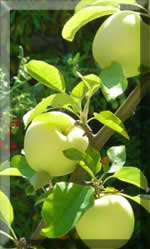 |
Developed from a Montgomery X Yellow Transparent cross, released by New York Fruit Testing in 1911. Similar in many ways to it's dominant parent Yellow Transparent, we use Lodi as a substitute due to it's resistance to fireblight. Lodi produces a reliable, extra early crop of large green cooking apples, hardy to -45 degrees. While claims of larger, firmer, longer keeping fruits than the mother plant (Yellow Transparent) are difficult to validate here, the disease resistance and abundant, early cooking apples make Lodi a serious contender in our northern kitchen orchards.
|
 |
A chance seedling discovered by J. Luke, Rosthern, Saskatchewan, evaluated and introduced by the Experimental Farm, Morden, Manitoba in 1961. This large fruit ripens in early October, 3.5" to 4" in diameter with a mottled red over a green background. Luke is rated as good for eating, excellent for cooking and sauce and keeps well in storage. Very winter hardy and well suited for our more difficult, cold, short season sites.
|
|
- McIntosh
- McClean
- Northern Light
- Snow/Famuse
- Spartan
- Wealthy
- Wolf River
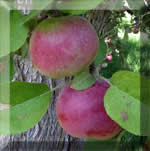 |
A chance seedling discovered circa: 1800 in Ontario, Canada, now widespread in many climates and cultural conditions. If one were to choose a single favorite apple for all purpose, flavor and reliability, the McIntosh would be a popular choice. Widely grown in Canada and the United States, Western Montana is ideally suited for this cultivar. The cool fall temperatures here in the Bitterroot seem to enhance the color and flavor of this fruit. While dozens of strains have been developed in recent years, the old original dark red, almost black, Mac' is still preferred by the connoisseurs of this antique variety. Many specimens of the original Mac' orchards planted in 1910 are still producing quality fruit in the Bitterroot. One in particular serves as our source of scion wood and sold here as Old 'Mac. While moderately susceptible to apple scab and rust, fear of forfeiting my Bitterroot Citizenship requires "high marks" for this established antique. Many consider McIntosh a great dessert apple and excellent for sauce and pie. I find them at their best late in the season.
|
 |
Hardy cultivar released from Canada in 1960 as a cross with Columbia X Melba. While the fruit is small, 2" to 2.5" in diameter, it is blessed with a beautiful light red blush over a pale yellow skin. This early season apple is great for eating out of hand and cooking, a big hit at our Farmer's Market and very winter hardy.
|
 |
A Haralson X McIntosh cross made in 1938 at Geneva, New York, introduced from North Dakota State University in 1990. This new cultivar ripens in mid-September with a glossy, bright red skin and conspicuous white leticels or dots. The fruit is 3" to 3.5" in diameter with a semi-firm white, sub-acid flesh similar to McIntosh. Northern Lights is very winter hardy and recommended for kitchen orchards in our colder regions.
|
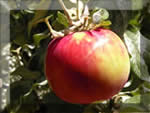 |
Origin is France, circa: 1600, introduced to the United States via Canada in 1730 and well planted in Western Montana by 1910. The snow apple ripens in late September with a beautiful red, almost purple, over a creamy thin and tender skin. This attractive skin covers a snow white, tender, spicy, aromatic flesh. Considered an excellent dessert apple, also used for cider and cooking. Snow apple stores well and is remembered as a stocking stuffer and carried to school by the Old Timers. This time honored antique is highly recommended for Western Montana.
|
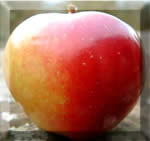 |
Developed from a McIntosh X Newton cross in Summerland, British Columbia in 1936. Spartan is heavily planted as a pollinator in commercial Mac orchards in British Columbia. The tree is vigorous, spreading, bears early and yields a heavy crop in the Bitterroot. Like the Mac, Spartan is round, medium in size with an intense dark red skin. The flesh is fine textured, crisp and juicy. Spartan is considered a late season apple here, ripens in late September to early October, ten days to two weeks after Mac, and are in stores until January. Rated as excellent for eating and cooking, Spartan also shows resistance to apple scab, rust and fireblight, a good choice for Western Montana plantings.
|
 |
This is a very popular antique variety in Western Montana, discovered in 1869 as a chance seedling in Minnesota. While it's parentage is unknown, recent DNA tests establish Wealthy as a parent of Haralson, hence Honeycrisp. Well represented in the 1910 plantings in the Bitterroot and early commercial orchards in Minnesota. Wealthy has it's own distinctive flavor and is a great dessert and cooking apple, also used for sauce and cider. Ripens in mid-September, two full weeks ahead of McIntosh and striped with bright red over a greenish yellow background. One box of Wealthy with two boxes of Mac was a favored recipe for blended cider as remembered by the Old Timers. Wealthy is hardy, with it's versatility and history making it valuable in areas where fireblight is not a major consideration.
|
 |
This enormous apple originated as an open pollinated seedling of Alexander near Wolf River, Wisconsin over 100 years ago. "One apple makes a pie" was the old saying. It has a beautiful bright, deep red over pale yellowish skin. The flesh has a slight yellow tinge, and is tender and juicy. Rated excellent for cooking and one of the best for pie. Wolf River ripens in late September, very winter hardy and is recommended for it's large fruit.
|
Back To Top
|























